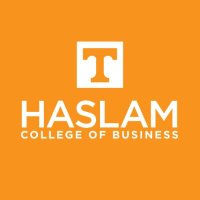On a Thursday morning in fall 2021, the University of Tennessee, Knoxville seniors weren’t sure what to expect from the next session of their capstone marketing course at the Haslam College of Business. As they took in the scenic view of a desert landscape surrounding them, they watched their fellow students fill the class space, where instructor Mark Collins stood at the front of a futuristic-looking auditorium.
These students weren’t on a field trip; they were in their apartments and dorm rooms, attending an experimental hybrid section of Marketing Strategy (MARK 460), which Collins believes to be the first class at UT to utilize virtual reality as a regular delivery modality.
“It’s definitely the first one to build it into the pedagogy of the class,” says Collins, distinguished lecturer of marketing at Haslam and director of the college’s Office of Technology-Enhanced Education. “Nursing has used some VR for particular modules or events, but this is the first class listed as such in UT’s timetable so students would know they were signing up for a class that was partially VR.”
Engaging Marketing Students in a New Way
VR technology has become common in fields like medicine where training involves high risk or high price tags, but Collins was inspired by marketers who had begun using the related technology of augmented reality, enabling users to view their physical surroundings through a phone or tablet and see computer-generated content such as a brand mascot overlaid on the space.
With the encouragement of Lane Morris, the college’s associate dean of undergraduate studies and student affairs, and Betsy Adams, assistant dean of finance and administration, as well as Alex Zablah, marketing department head, Collins obtained Oculus Quest 2 headsets to interface with the VR platform Spatial, which provides high-quality audio and video and integrates easily with smartphones and Microsoft Office.
Collins enlisted the help of Alex Weber, a first-year student in Haslam’s full-time MBA program who won funding from the college’s fall 2021 Vol Court Pitch Competition for EVRLASTING, his business that makes VR recordings of weddings and other events. On the first in-person day of class, Weber gave a presentation about how to operate the equipment, and students checked out the units they would keep for the semester, signing a financial waiver and a liability waiver (the latter mainly for vertigo, which some users experience when wearing the headset).
For this hybrid section of MARK 460, Collins planned for six or eight class sessions in the middle of the semester to be delivered via VR and the rest face-to-face. In the same semester, he taught another section of the course that was completely face-to-face. He says that while both sections achieved the required level of learning for the class, he believes the VR class absorbed the material at a higher level.
“Because it was so different, it made them focus and pay attention a lot more,” says Collins, who makes a clear distinction between VR and other types of remote learning. “The interaction and engagement by the students in VR is night and day compared to if we only had met on Zoom. Part of it, I’m sure, is the fact that they’re an avatar, so they don’t feel that self-consciousness.”
Bridgette Liederbach, a Haslam marketing major scheduled to graduate in May 2022, agrees.
“Having an avatar makes the classroom experience feel personal and like we are all in the room together but also makes it less intimidating,” says Liederbach, who — like most of the students in the class — had no previous experience with VR. “Zoom sometimes makes me uncomfortable to have my camera on and [unmute myself] because I know everyone will see my face pop up on their screen, but using Spatial makes talking in class easier.”
Potential for Teaching Across Disciplines
For future sections of the course, Collins wants to take his entire class on a virtual field trip to a store, using VR footage of retail aisles that Weber has already shot.
“I want to stand there with them in front of that and say, ‘OK, what’s happening here? Why are there 13 different types of Cheez-Its?’” he says. “Then we can go down the aisle and see how the competitors are reacting, and what they’re doing that kind of matches up with what Cheez-It did.”
Other Haslam faculty members have approached Collins about the feasibility of using VR in their courses, and he is enthusiastic about the possibilities, especially as more units, apps and software become available at lower price points. While he doesn’t recommend teaching full courses exclusively via VR yet, he imagines financial reports in which students could reach out to pick up information and place it where it belongs, or a VR supply chain where they could identify and manipulate bottlenecks.
“Across all disciplines, there are moments where we want the students to understand something at a really deep and meaningful level, and we can use VR to make that engagement and interaction happen,” he says. “I can see using it in a focused, short time span, to keep it really powerful rather than just becoming the new normal.”
—
CONTACT:
Stacy Estep, writer/publicist, sestep3@utk.edu

